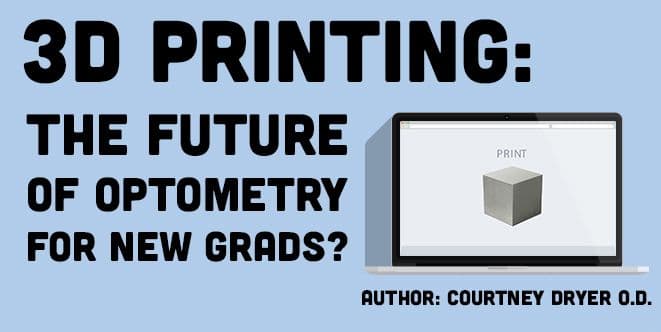From the runways of Paris, to an electric neighborhood car...every industry has embraced 3D printing.
In 2011, 3D printing was expected to change everything. In fact, New Scientist magazine1 boldly declared,
“We are smack bang in the middle of a second industrial revolution.”
3D printing has undoubtedly also begun to affect the ophthalmic and optometric industries.
What is 3D printing?
3D printing is the process of making 3D objects digitally. An object is created by layering horizontal slices that are then blended together using a 3D printer.1 The first 3D printers were actually developed in the 1980's by Charles Hull.2
How is it being used?
3D printing is currently being used in many industries from jewelry to athletic cleats. Printers can print plastics, metals, and even some food is in the works at NASA.2
How is it being used in healthcare?
Pharmaceutical development
Researchers are hopeful that if bio-printed tissues were available, new pharmaceuticals could be tested to “see how drugs are metabolized and what side effects result.” They hope to produce a “fail-fast model” to identify toxic effects prior to spending money on testing.2
Organ development
The ultimate goal of the medical community regarding 3D printing is the development of entire organs for transplants. Materials Scientist from Harvard, Jennifer Lewis, admits “ the grand challenge is to make a whole kidney - that is our moon shot.”
How will it be used in optometry?
Correcting Refractive Errors
The Italian research company, MHOX are developing their own technology called EYE (Enhance Your Eye). The goal of their technology is to remove the eyes you were born with and replace them with 3D printed eyes. The nerves and impulses all utilize 3D technology, possibly giving the patient better than 20/20 vision. MHOX is using the same technologies used for medical devices, implants, and prosthetics.
Partner and Lead Designer, Filippo Nassetti, says, “In the near future it would be possible to easily print organic functional body parts, allowing the human to replace defected districts or enhance standard performance.” They propose the eyes may be available as soon as 2027.3
Eye Disease
Researchers at the University of Cambridge successfully 3D printed retinal cells of adult rats in 2013. Professor Keith Martin reported, “We’ve demonstrated that you can take cells from the retina and you can effectively separate them out. These can be put in an inkjet printer and we can print those cells out in any pattern we like and we’ve shown that those cells can survive and thrive.”6 This research has the potential to help with our treatment of Age-related Macular Degeneration and Glaucoma.
Eyeglass Lenses
In early July 2015, Dutch company LUXeXceL, printed the world’s first 3D lenses for the Netherland’s Royal Highnesses, King Willem Alexander and Queen Maxima. The company primarily focuses on printing 3D LED lighting.5
Frames
A simple google search of “3D printed eyewear,” brings up 100’s of start-up companies offering 3D printing options. Many of them have dates in the future listed for availability. When I attended Vision Expo in 2014, there were several vendors and frame companies offering 3D frame technology.
I learned quickly there are two important factors to consider: the material of the frame, and the quality of the hinges. Both are key components in any pair of frames, whether 3D printed or not. In the luxury eyewear market, both Mykita and Monoqool have accomplished this successfully. Your patients who love light-weight frames will be fans of this technology.
3D printed eyewear will most certainly be a part of our opticals in the future. Currently, the materials are low cost, but the technology can be expensive. The technology for “in office” use is not as progressive as those used by manufacturers. If this is the technology of the future…will we need eyewear manufacturing companies? Will we as optometrists print eyewear in our opticals? If so…how will we set apart our own brands of eyewear?
Prosthetics
Custom made prosthetics were being made of acrylic and hand painted, taking between 4-8 hours. Advancements in 3D printing allow prosthetics to be produced at a rate of 150 an hour; therefore, reducing the cost by 97 percent. The cost for your patient can decrease from $5,000 to $150.4
3D printing has the ability to substantially change the way we practice optometry.
3D printing has the potential to substantially cut costs on eyewear inventories, but may make optical differentiation more difficult. It also has the potential to lead to innovations in pharmaceuticals, as well as our management of disease and refractive conditions.
References
- “What Is 3D Printing? How Does 3D Printing Work?” 3D Printing. N.p., n.d. Web. 13 July 2015.
- Groopman, Jerome. “How 3-D Printing Is Changing Medicine – The New Yorker.” The New Yorker. Medical Dispatch, 24 Nov. 2014. Web. 13 July 2015.
- Millsaps, Bridget Butler. “Italian Researchers Expect 3D Printed Eyes by 2027, Providing Enhanced Vision & WiFi Connection.” 3DPrintcom. N.p., 03 Mar. 2015. Web. 13 July 2015.
- Strauss, Mark. “3D Printed Eyes Are Insanely Cheap Prosthetics and Look Perfect.” Io9. N.p., 24 Apr. 2014. Web. 13 July 2015.
- “Worlds First Fully 3D Printed Glasses by LUXeXceL – LUXeXceL | 3D Printed Optics.” LUXeXceL 3D Printed Optics RSS. LUXeXceL, 20 June 2013. Web. 13 July 2015.
- Howarth, Dan. “3D-printed Eye Cells Could “cure Blindness” | Technology | Dezeen.” Dezeen 3Dprinted Eye Cells Could Cure Blindness Comments. N.p., 18 Dec. 2013. Web. 13 July 2015.
- ”3D Printing: The Technology That Changes Everything – New Scientist.” New Scientist. N.p., 27 July 2011. Web. 13 July 2015.
